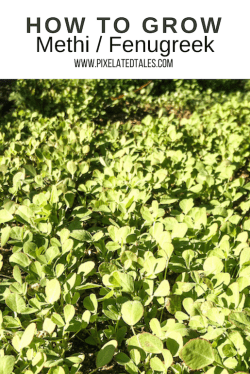We have been growing methi at home since last year. Just yesterday we made Methi puri from our homegrown Methi leaves and coriander. In this post, I will share all the tips to grow healthy Methi at home.
The credit for the current production of Methi goes to my in-laws who have been busy turning our backyard into a vegetable garden. They have years of experience in growing vegetables both on farms and at home. And now they are utilizing their immense knowledge of gardening to make my home garden more functional.

How to grow Methi at home
Seeds – Methi grows from the seeds, which are easily found in Indian homes. We bought ours from our local grocery store. You can also soak the seeds in a damp cloth overnight for better chances of germination. I didn’t soak them overnight and directly sowed them in the soil. The seeds would germinate in 3-4 days.
Sunlight – Choose a sunny spot (at least 4-5 hours of sunlight) in your garden or pot and let them grow there until they mature. I usually don’t have much success in transplanting vegetable saplings. Harsh sunlight in summer and high temperatures (> 40 degrees Celcius) can damage the leaves. The spot in my garden gets late morning and afternoon sun.
Soil – Tile the soil properly before sowing the seeds. Methi needs water but does not like to be waterlogged. Choose well-draining soil. You do not need fertilizers to grow Methi. In fact, Methi plants are great for replenishing the nitrogen content in the soil.
Weather – Methi grows well when the soil starts warming up after winter. Late spring to summer is an excellent time to grow Methi. Having said that, we had success in growing Methi in Sydney winter too (temperature goes as low as 4 degrees Celcius in the morning). They took a bit longer to germinate in winter but grew up well nevertheless.


You can grow other herbs and vegetables alongside Methi. Currently, we are growing coriander, tomato, spinach, and green chilies in the same area.

Methi or Fenugreek is a unique herb with numerous benefits like lowering cholesterol, controlling diabetes, rich in many important vitamins, and prevent anemia. You can read about all the benefits in this post on the benefits of fenugreek. Please be careful while consuming this herb during pregnancy as it can cause uterine contractions.
Here’s a plate of Methi Puri and Kadhi. To make the puri, Methi leaves were first cooked and then mixed with wheat flour, along with homegrown green coriander, Indian spices, and salt.

Here’s a picture of my first batch of Methi, which we then used to make Methi Paratha.

Pin for Later

Wow! Raj, your veggie garden looks impressive! It needs special people like you and your family to be able to grow such healthy plants and veggies, you know! <3
Thank you 😀 I am so glad my in laws love gardening. It also keeps them busy while we are working.